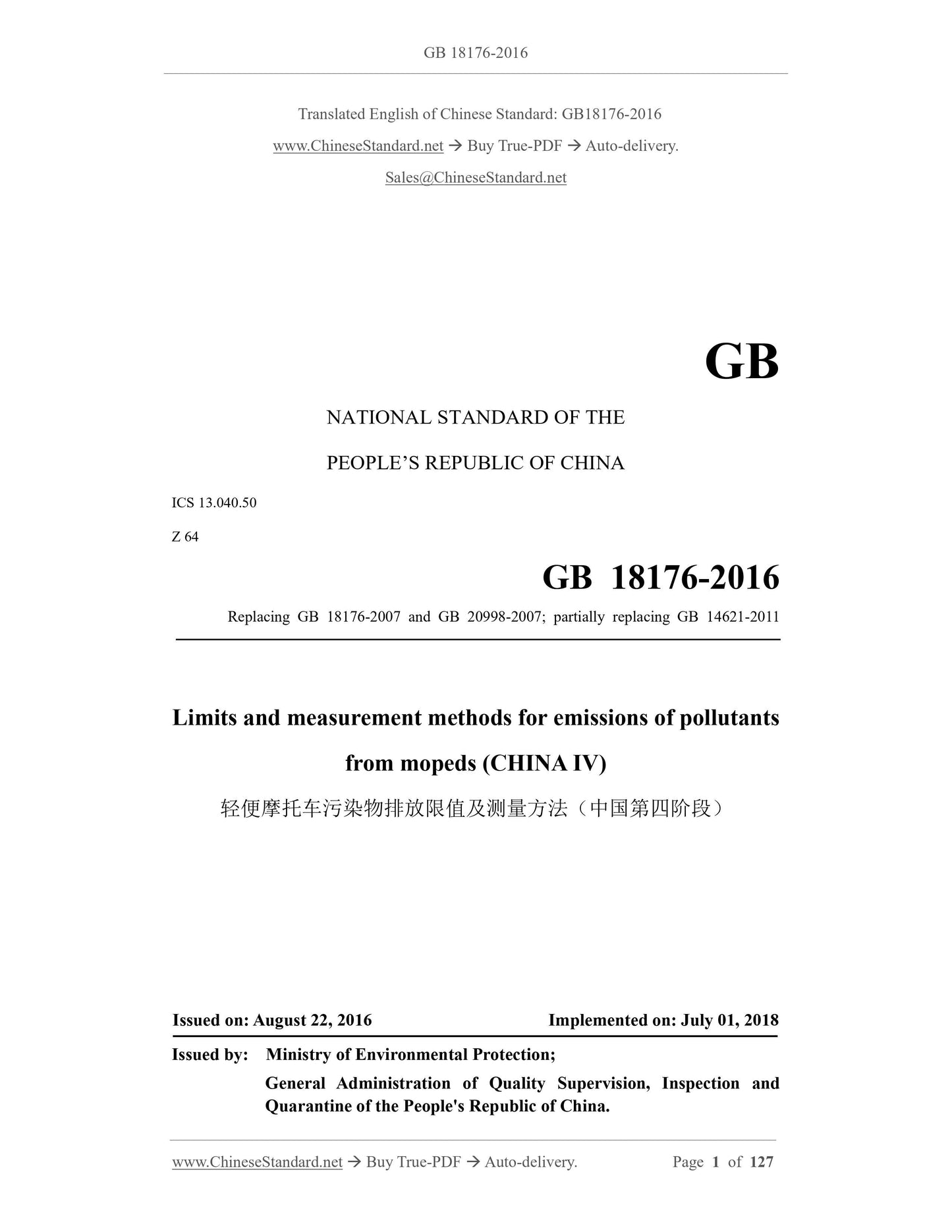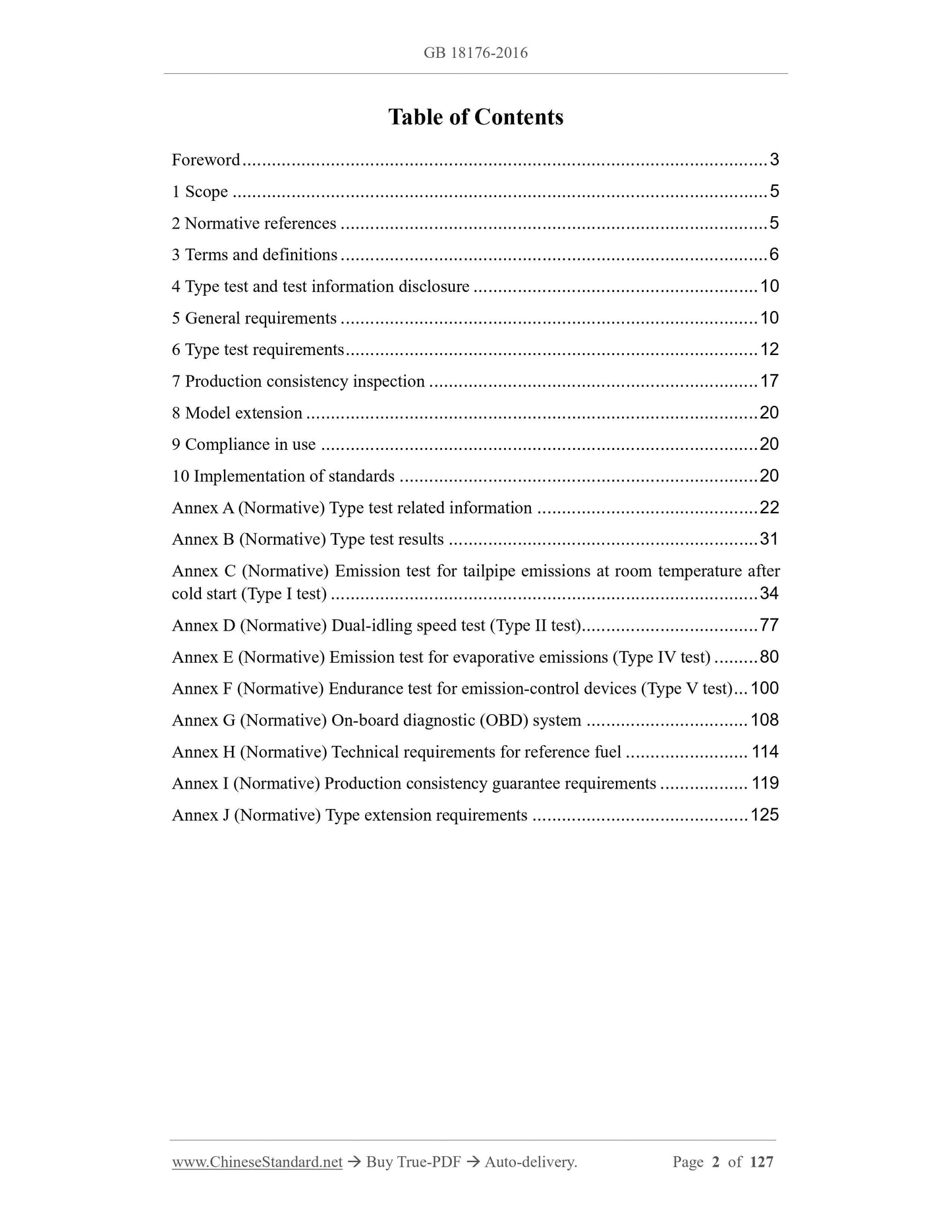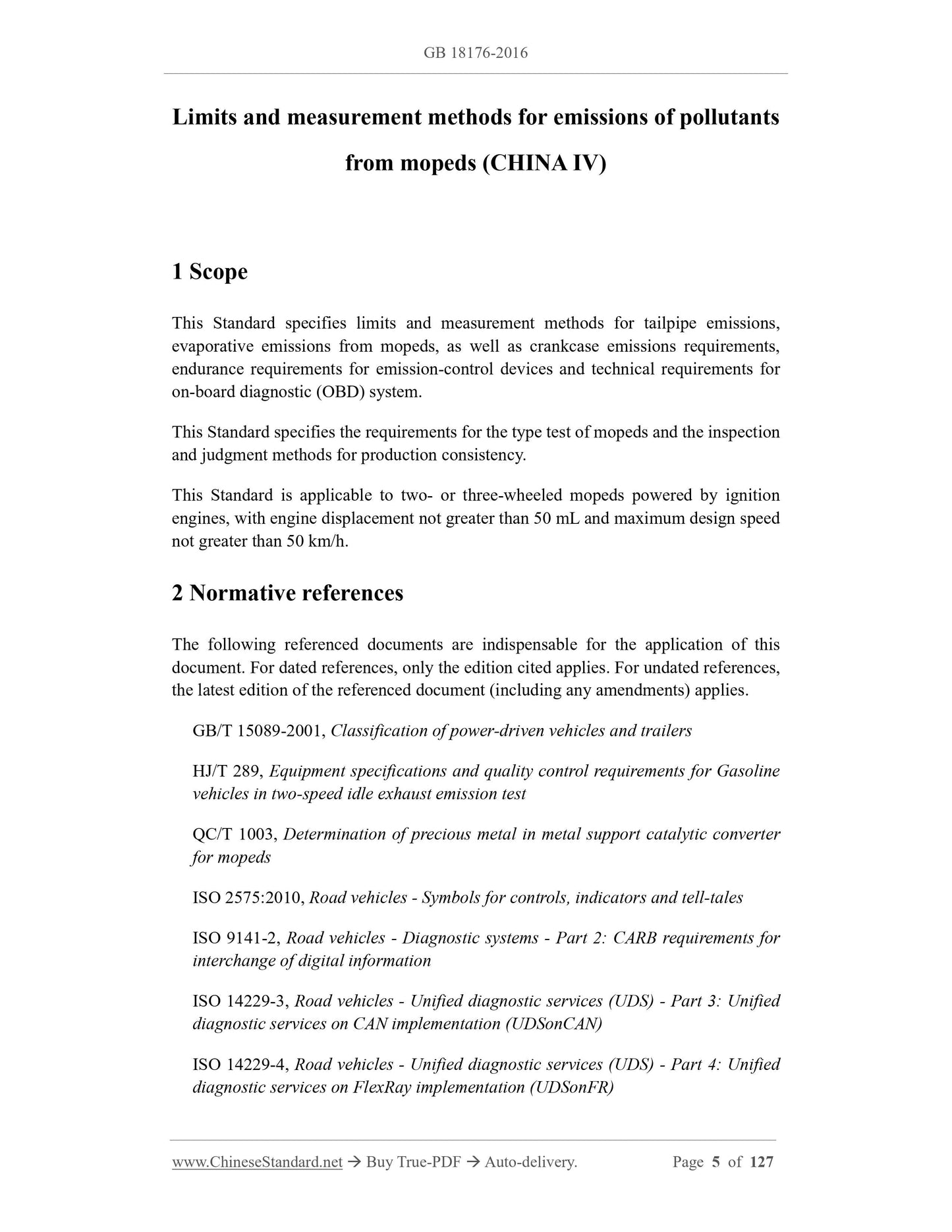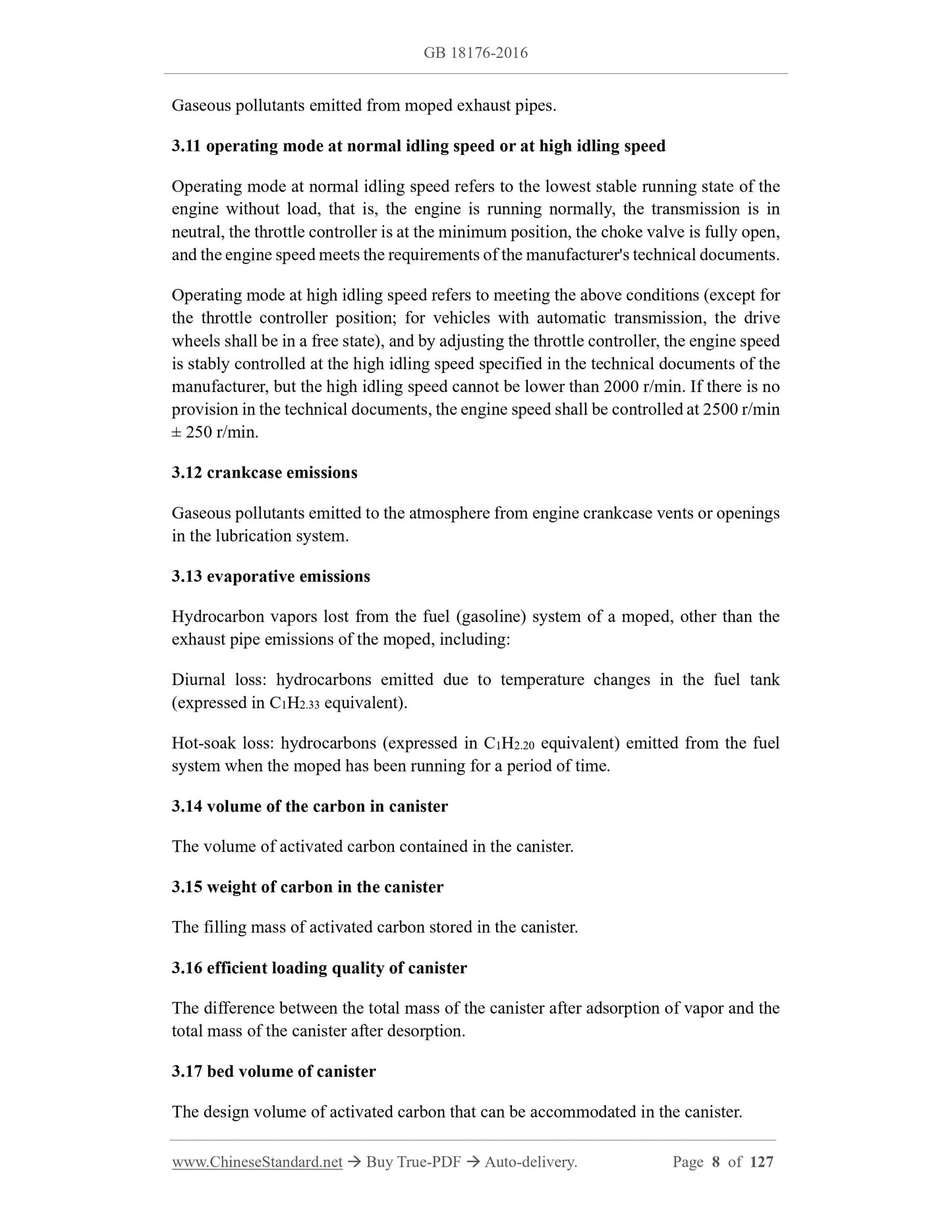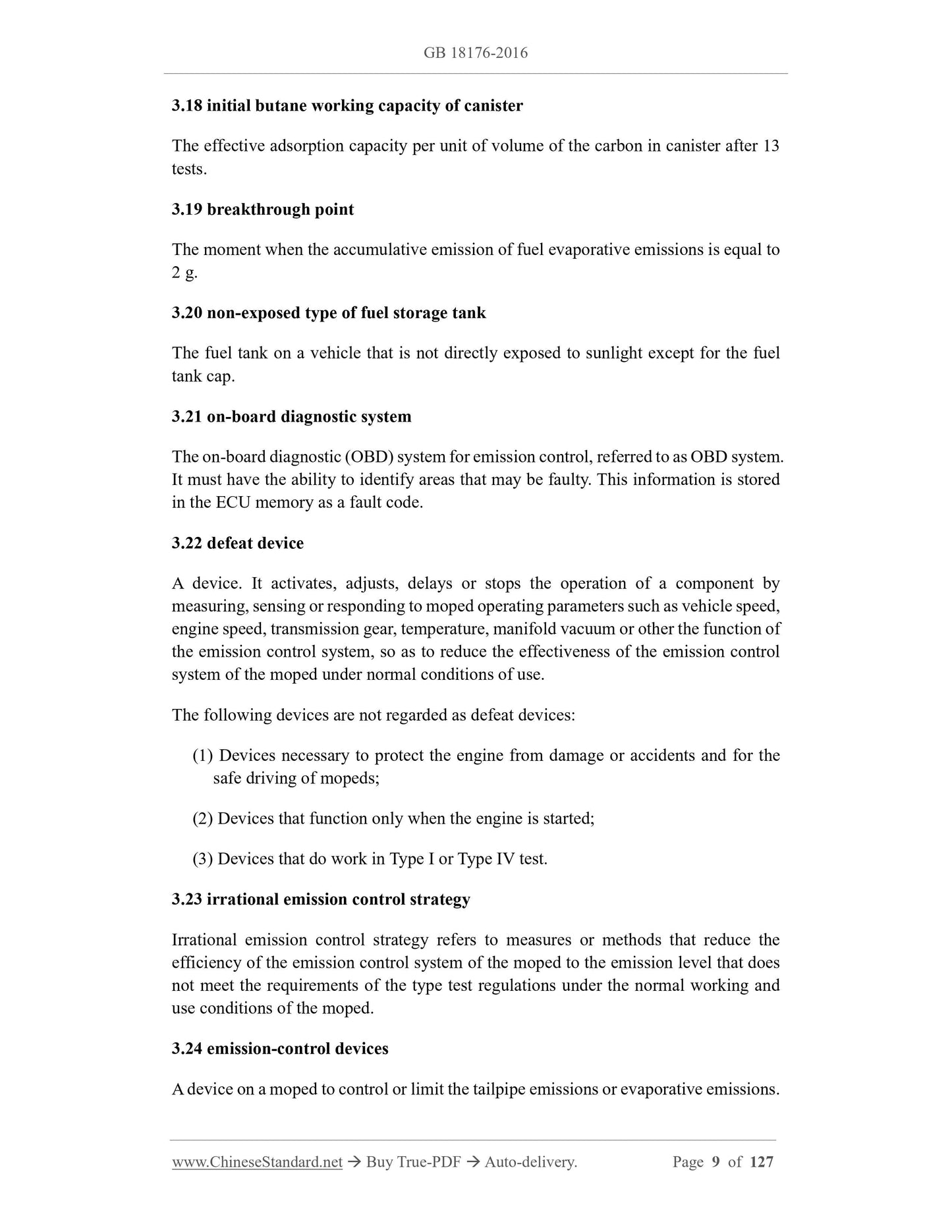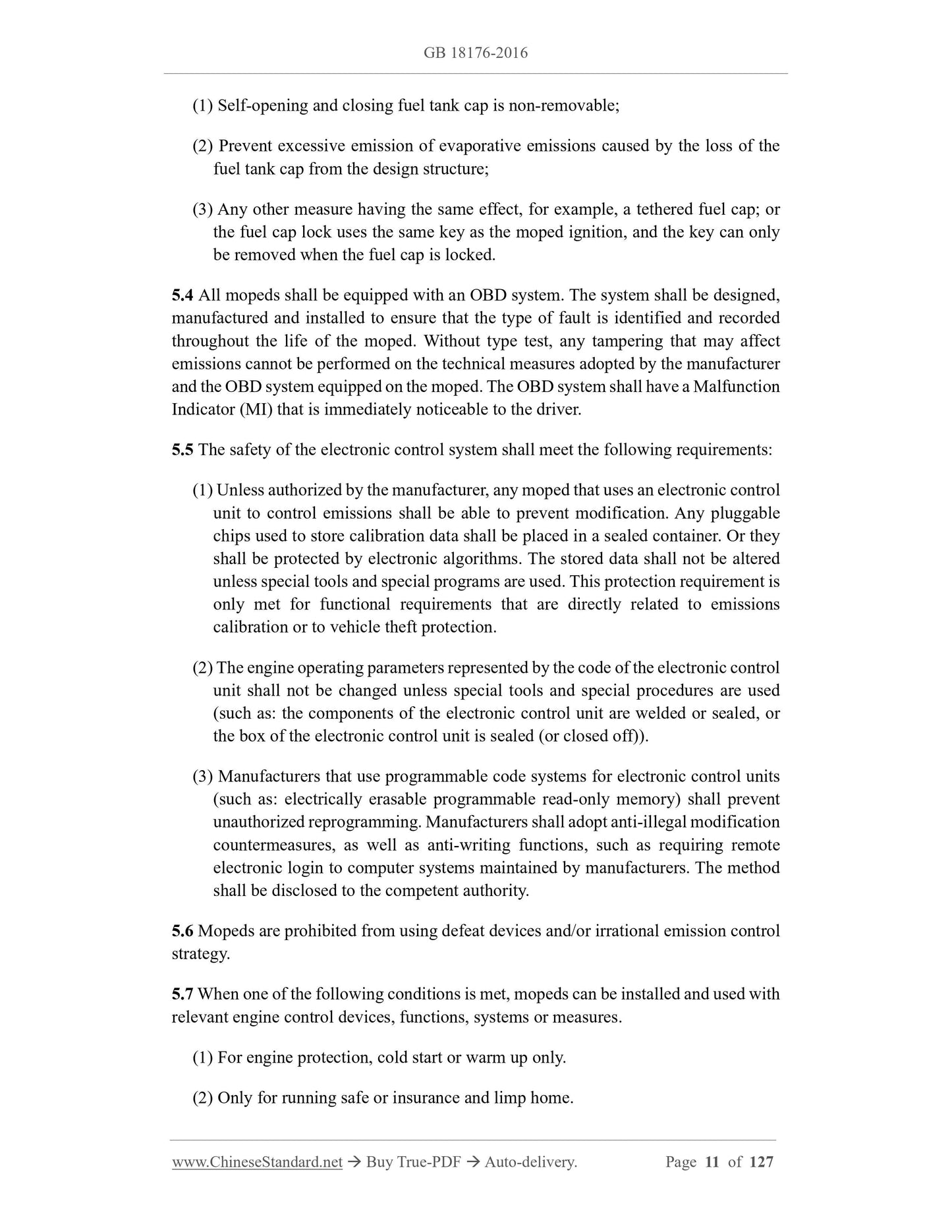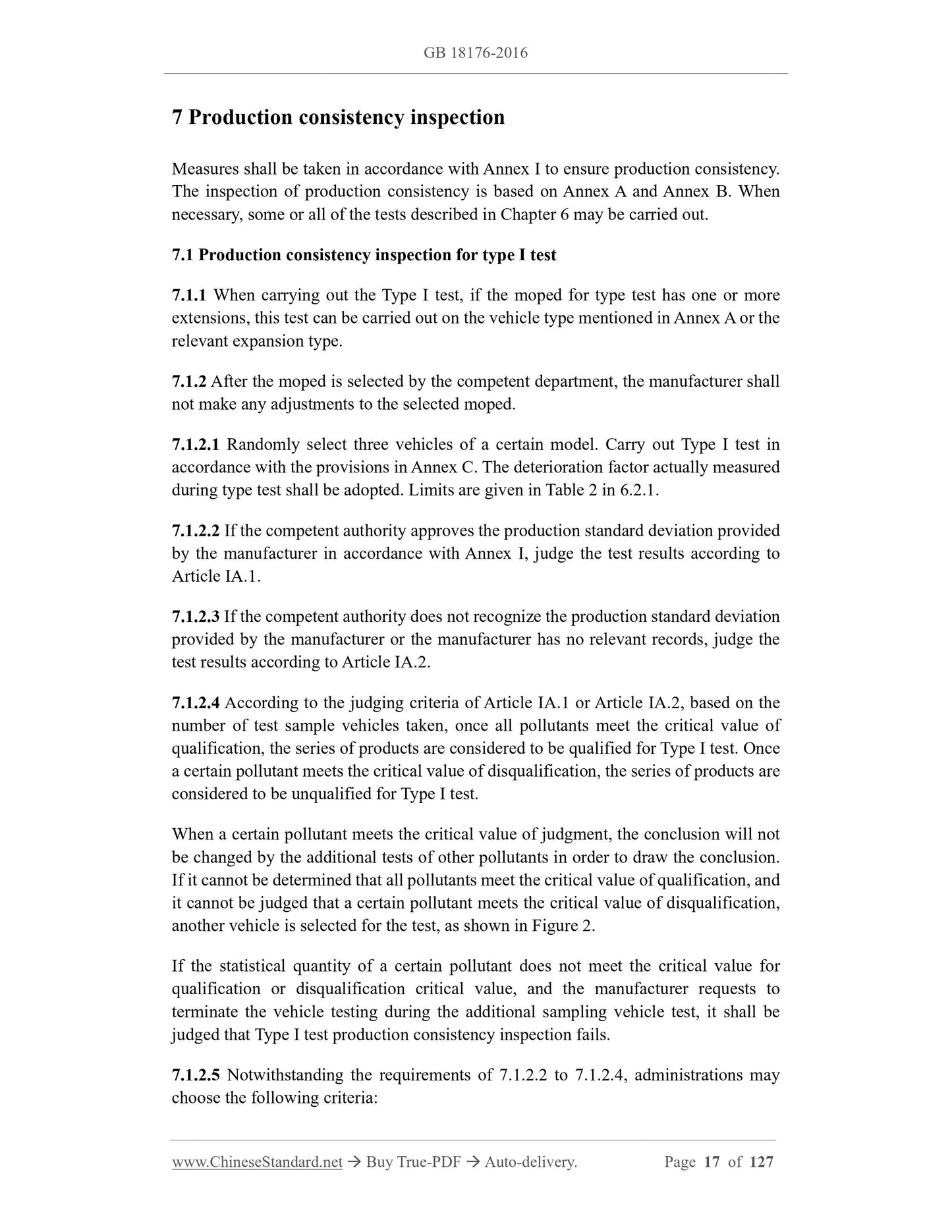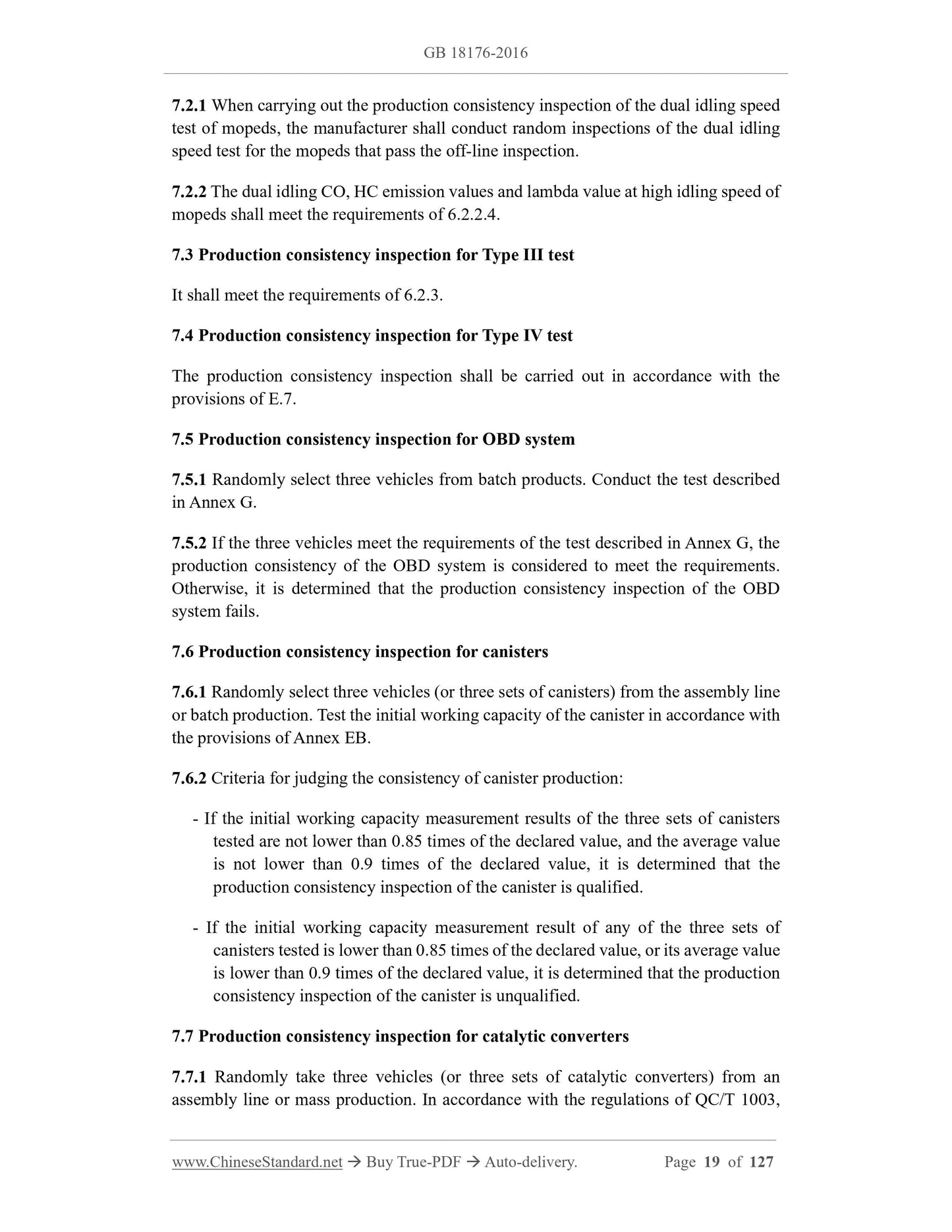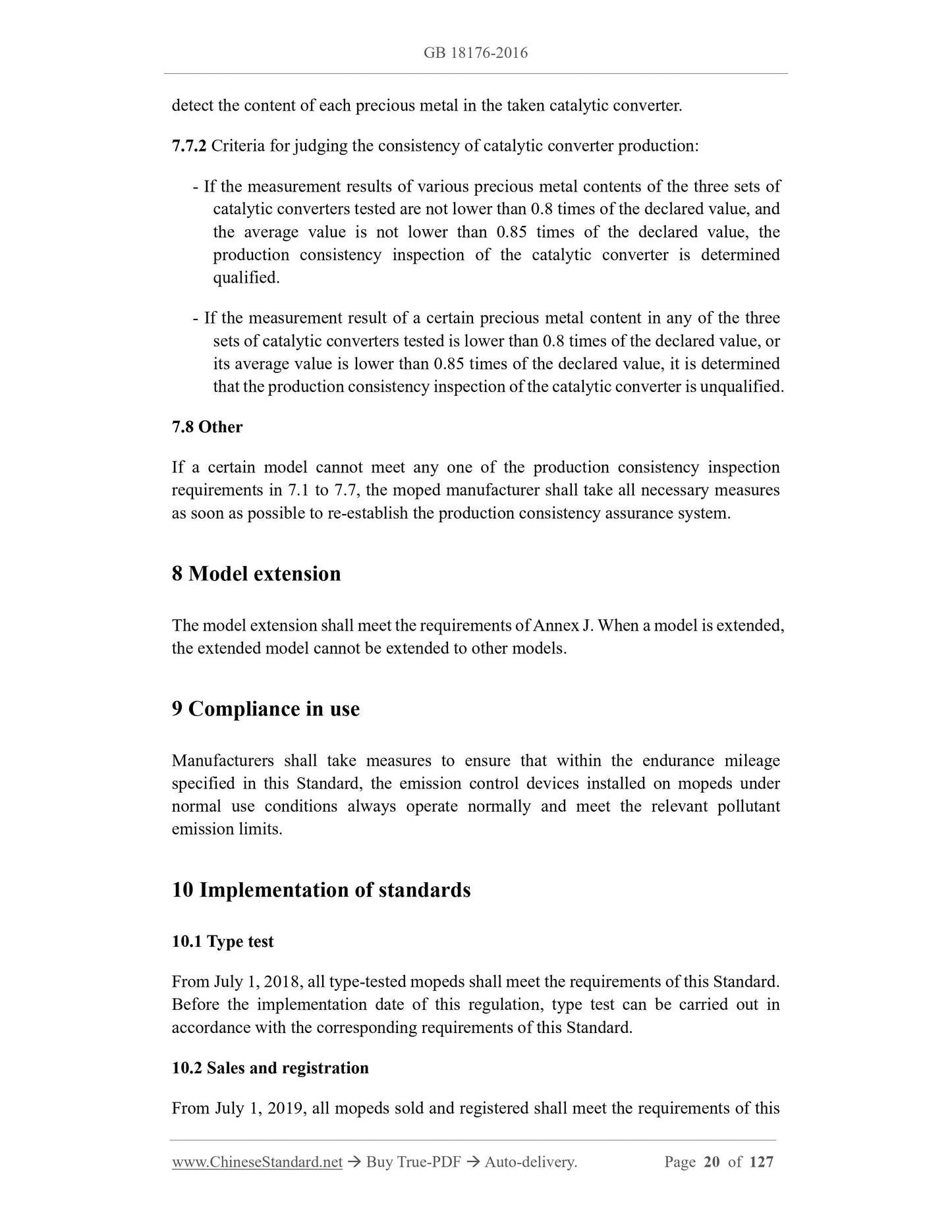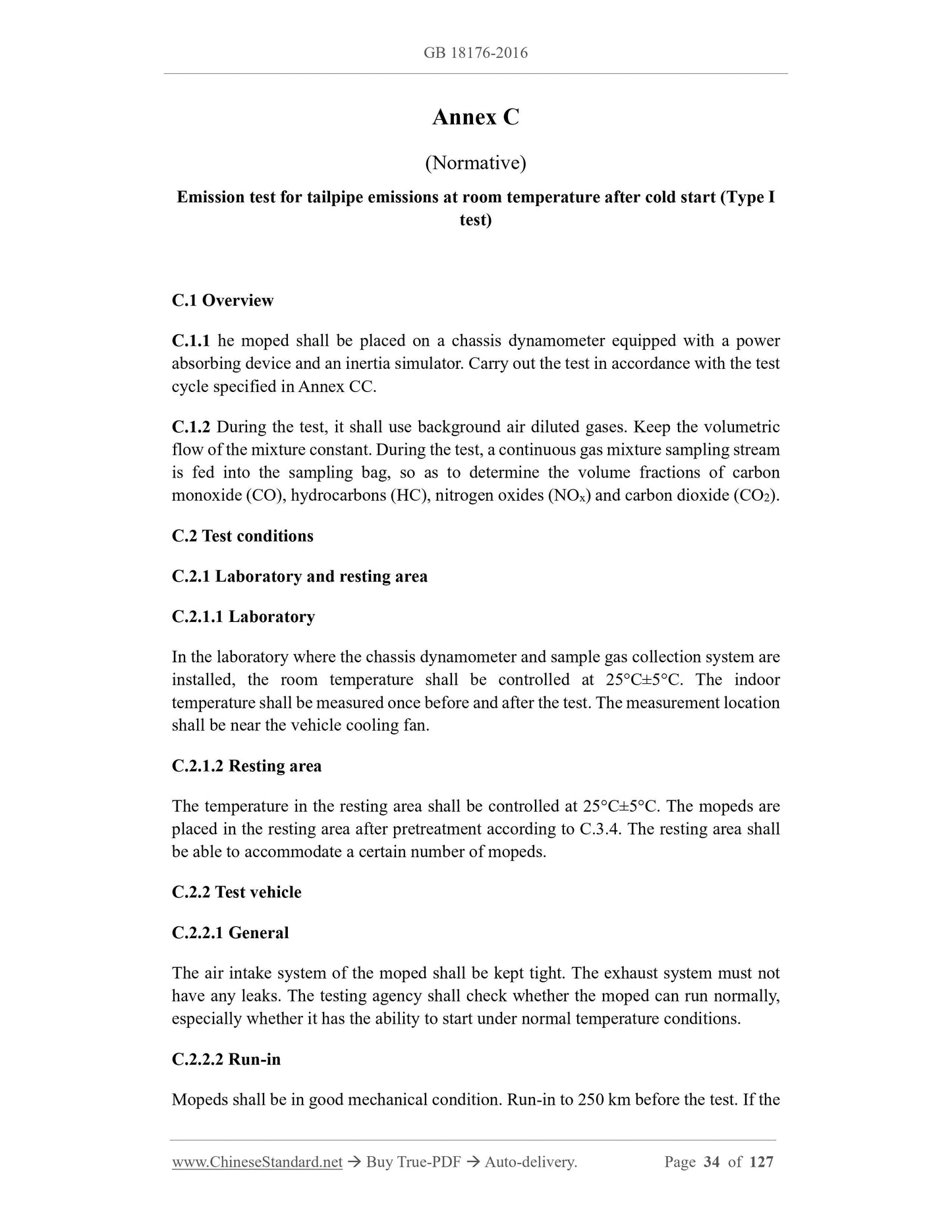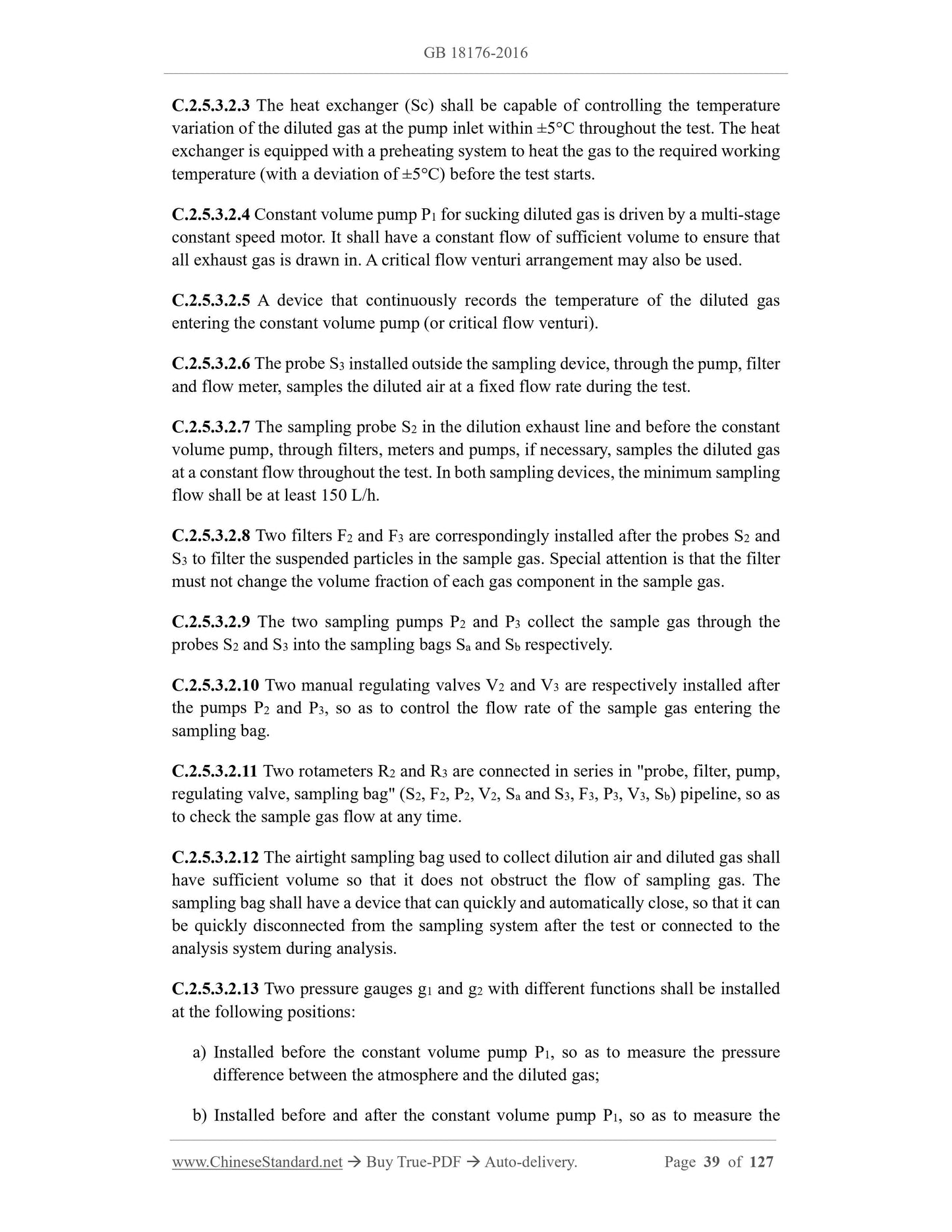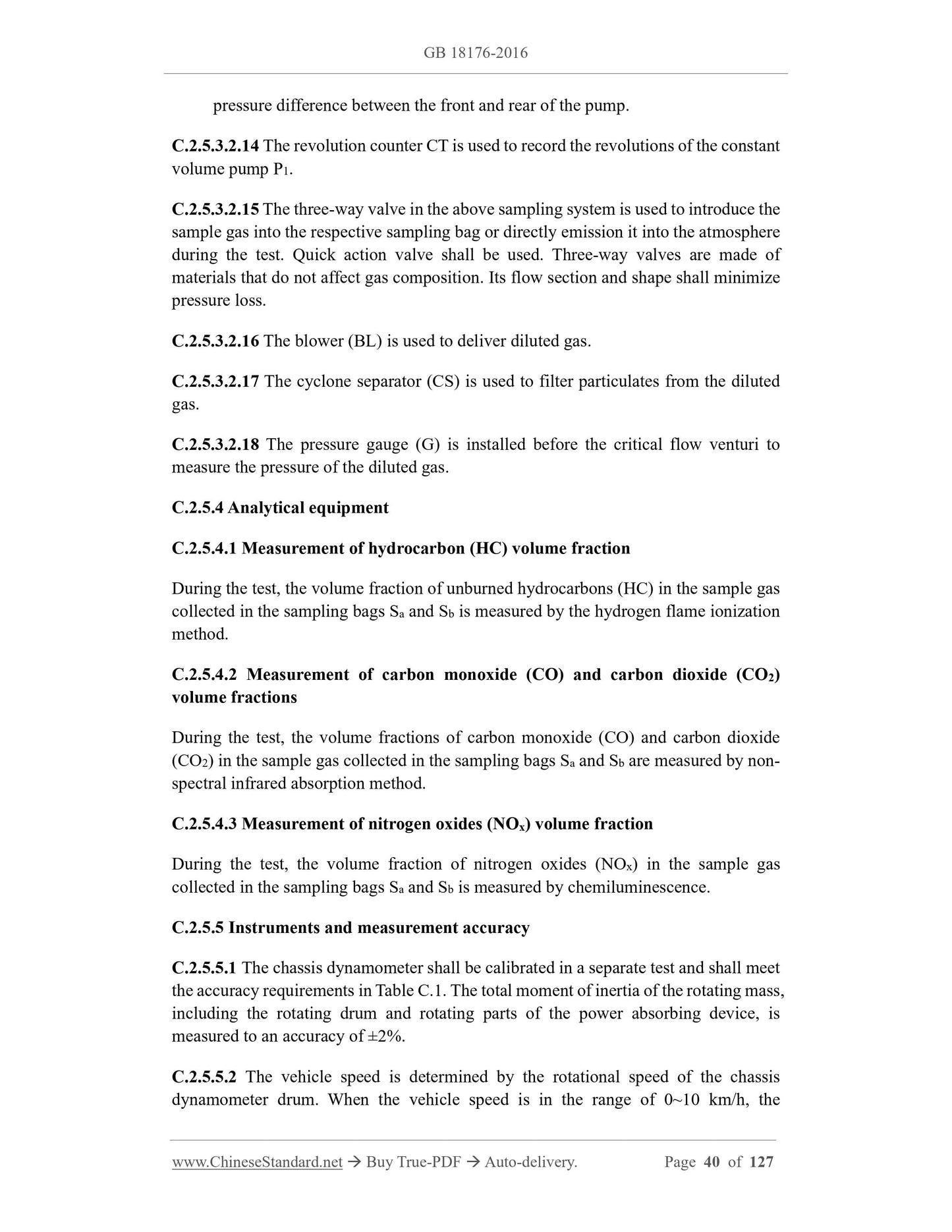1
/
af
12
PayPal, credit cards. Download editable-PDF & invoice in 1 second!
GB 18176-2016 English PDF (GB18176-2016)
GB 18176-2016 English PDF (GB18176-2016)
Normalpris
$1,060.00 USD
Normalpris
Udsalgspris
$1,060.00 USD
Stykpris
/
pr.
Levering beregnes ved betaling.
Tilgængelighed for afhentning kunne ikke indlæses
Delivery: 3 seconds. Download true-PDF + Invoice.
Get QUOTATION in 1-minute: Click GB 18176-2016
Historical versions: GB 18176-2016
Preview True-PDF (Reload/Scroll if blank)
GB 18176-2016: Limits and measurement methods for emissions of pollutants from mopeds on the running mode (CHINA stage IV)
GB 18176-2016
GB
NATIONAL STANDARD OF THE
PEOPLE’S REPUBLIC OF CHINA
ICS 13.040.50
Z 64
Replacing GB 18176-2007 and GB 20998-2007; partially replacing GB 14621-2011
Limits and measurement methods for emissions of pollutants
from mopeds (CHINA Ⅳ)
ISSUED ON: AUGUST 22, 2016
IMPLEMENTED ON: JULY 01, 2018
Issued by: Ministry of Environmental Protection;
General Administration of Quality Supervision, Inspection and
Quarantine of the People's Republic of China.
Table of Contents
Foreword ... 3
1 Scope ... 5
2 Normative references ... 5
3 Terms and definitions ... 6
4 Type test and test information disclosure ... 10
5 General requirements ... 10
6 Type test requirements ... 12
7 Production consistency inspection ... 17
8 Model extension ... 20
9 Compliance in use ... 20
10 Implementation of standards ... 20
Annex A (Normative) Type test related information ... 22
Annex B (Normative) Type test results ... 31
Annex C (Normative) Emission test for tailpipe emissions at room temperature after
cold start (Type I test) ... 34
Annex D (Normative) Dual-idling speed test (Type II test)... 77
Annex E (Normative) Emission test for evaporative emissions (Type IV test) ... 80
Annex F (Normative) Endurance test for emission-control devices (Type V test) ... 100
Annex G (Normative) On-board diagnostic (OBD) system ... 108
Annex H (Normative) Technical requirements for reference fuel ... 114
Annex I (Normative) Production consistency guarantee requirements ... 119
Annex J (Normative) Type extension requirements ... 125
Limits and measurement methods for emissions of pollutants
from mopeds (CHINA Ⅳ)
1 Scope
This Standard specifies limits and measurement methods for tailpipe emissions,
evaporative emissions from mopeds, as well as crankcase emissions requirements,
endurance requirements for emission-control devices and technical requirements for
on-board diagnostic (OBD) system.
This Standard specifies the requirements for the type test of mopeds and the inspection
and judgment methods for production consistency.
This Standard is applicable to two- or three-wheeled mopeds powered by ignition
engines, with engine displacement not greater than 50 mL and maximum design speed
not greater than 50 km/h.
2 Normative references
The following referenced documents are indispensable for the application of this
document. For dated references, only the edition cited applies. For undated references,
the latest edition of the referenced document (including any amendments) applies.
GB/T 15089-2001, Classification of power-driven vehicles and trailers
HJ/T 289, Equipment specifications and quality control requirements for Gasoline
vehicles in two-speed idle exhaust emission test
QC/T 1003, Determination of precious metal in metal support catalytic converter
for mopeds
ISO 2575:2010, Road vehicles - Symbols for controls, indicators and tell-tales
ISO 9141-2, Road vehicles - Diagnostic systems - Part 2: CARB requirements for
interchange of digital information
ISO 14229-3, Road vehicles - Unified diagnostic services (UDS) - Part 3: Unified
diagnostic services on CAN implementation (UDSonCAN)
ISO 14229-4, Road vehicles - Unified diagnostic services (UDS) - Part 4: Unified
diagnostic services on FlexRay implementation (UDSonFR)
Gaseous pollutants emitted from moped exhaust pipes.
3.11 operating mode at normal idling speed or at high idling speed
Operating mode at normal idling speed refers to the lowest stable running state of the
engine without load, that is, the engine is running normally, the transmission is in
neutral, the throttle controller is at the minimum position, the choke valve is fully open,
and the engine speed meets the requirements of the manufacturer's technical documents.
Operating mode at high idling speed refers to meeting the above conditions (except for
the throttle controller position; for vehicles with automatic transmission, the drive
wheels shall be in a free state), and by adjusting the throttle controller, the engine speed
is stably controlled at the high idling speed specified in the technical documents of the
manufacturer, but the high idling speed cannot be lower than 2000 r/min. If there is no
provision in the technical documents, the engine speed shall be controlled at 2500 r/min
± 250 r/min.
3.12 crankcase emissions
Gaseous pollutants emitted to the atmosphere from engine crankcase vents or openings
in the lubrication system.
3.13 evaporative emissions
Hydrocarbon vapors lost from the fuel (gasoline) system of a moped, other than the
exhaust pipe emissions of the moped, including:
Diurnal loss: hydrocarbons emitted due to temperature changes in the fuel tank
(expressed in C1H2.33 equivalent).
Hot-soak loss: hydrocarbons (expressed in C1H2.20 equivalent) emitted from the fuel
system when the moped has been running for a period of time.
3.14 volume of the carbon in canister
The volume of activated carbon contained in the canister.
3.15 weight of carbon in the canister
The filling mass of activated carbon stored in the canister.
3.16 efficient loading quality of canister
The difference between the total mass of the canister after adsorption of vapor and the
total mass of the canister after desorption.
3.17 bed volume of canister
The design volume of activated carbon that can be accommodated in the canister.
3.18 initial butane working capacity of canister
The effective adsorption capacity per unit of volume of the carbon in canister after 13
tests.
3.19 breakthrough point
The moment when the accumulative emission of fuel evaporative emissions is equal to
2 g.
3.20 non-exposed type of fuel storage tank
The fuel tank on a vehicle that is not directly exposed to sunlight except for the fuel
tank cap.
3.21 on-board diagnostic system
The on-board diagnostic (OBD) system for emission control, referred to as OBD system.
It must have the ability to identify areas that may be faulty. This information is stored
in the ECU memory as a fault code.
3.22 defeat device
A device. It activates, adjusts, delays or stops the operation of a component by
measuring, sensing or responding to moped operating parameters such as vehicle speed,
engine speed, transmission gear, temperature, manifold vacuum or other the function of
the emission control system, so as to reduce the effectiveness of the emission control
system of the moped under normal conditions of use.
The following devices are not regarded as defeat devices:
(1) Devices necessary to protect the engine from damage or accidents and for the
safe driving of mopeds;
(2) Devices that function only when the engine is started;
(3) Devices that do work in Type I or Type IV test.
3.23 irrational emission control strategy
Irrational emission control strategy refers to measures or methods that reduce the
efficiency of the emission control system of the moped to the emission level that does
not meet the requirements of the type test regulations under the normal working and
use conditions of the moped.
3.24 emission-control devices
A device on a moped to control or limit the tailpipe emissions or evaporative emissions.
(1) Self-opening and closing fuel tank cap is non-removable;
(2) Prevent excessive emission of evaporative emissions caused by the loss of the
fuel tank cap from the design structure;
(3) Any other measure having the same effect, for example, a tethered fuel cap; or
the fuel ca...
Get QUOTATION in 1-minute: Click GB 18176-2016
Historical versions: GB 18176-2016
Preview True-PDF (Reload/Scroll if blank)
GB 18176-2016: Limits and measurement methods for emissions of pollutants from mopeds on the running mode (CHINA stage IV)
GB 18176-2016
GB
NATIONAL STANDARD OF THE
PEOPLE’S REPUBLIC OF CHINA
ICS 13.040.50
Z 64
Replacing GB 18176-2007 and GB 20998-2007; partially replacing GB 14621-2011
Limits and measurement methods for emissions of pollutants
from mopeds (CHINA Ⅳ)
ISSUED ON: AUGUST 22, 2016
IMPLEMENTED ON: JULY 01, 2018
Issued by: Ministry of Environmental Protection;
General Administration of Quality Supervision, Inspection and
Quarantine of the People's Republic of China.
Table of Contents
Foreword ... 3
1 Scope ... 5
2 Normative references ... 5
3 Terms and definitions ... 6
4 Type test and test information disclosure ... 10
5 General requirements ... 10
6 Type test requirements ... 12
7 Production consistency inspection ... 17
8 Model extension ... 20
9 Compliance in use ... 20
10 Implementation of standards ... 20
Annex A (Normative) Type test related information ... 22
Annex B (Normative) Type test results ... 31
Annex C (Normative) Emission test for tailpipe emissions at room temperature after
cold start (Type I test) ... 34
Annex D (Normative) Dual-idling speed test (Type II test)... 77
Annex E (Normative) Emission test for evaporative emissions (Type IV test) ... 80
Annex F (Normative) Endurance test for emission-control devices (Type V test) ... 100
Annex G (Normative) On-board diagnostic (OBD) system ... 108
Annex H (Normative) Technical requirements for reference fuel ... 114
Annex I (Normative) Production consistency guarantee requirements ... 119
Annex J (Normative) Type extension requirements ... 125
Limits and measurement methods for emissions of pollutants
from mopeds (CHINA Ⅳ)
1 Scope
This Standard specifies limits and measurement methods for tailpipe emissions,
evaporative emissions from mopeds, as well as crankcase emissions requirements,
endurance requirements for emission-control devices and technical requirements for
on-board diagnostic (OBD) system.
This Standard specifies the requirements for the type test of mopeds and the inspection
and judgment methods for production consistency.
This Standard is applicable to two- or three-wheeled mopeds powered by ignition
engines, with engine displacement not greater than 50 mL and maximum design speed
not greater than 50 km/h.
2 Normative references
The following referenced documents are indispensable for the application of this
document. For dated references, only the edition cited applies. For undated references,
the latest edition of the referenced document (including any amendments) applies.
GB/T 15089-2001, Classification of power-driven vehicles and trailers
HJ/T 289, Equipment specifications and quality control requirements for Gasoline
vehicles in two-speed idle exhaust emission test
QC/T 1003, Determination of precious metal in metal support catalytic converter
for mopeds
ISO 2575:2010, Road vehicles - Symbols for controls, indicators and tell-tales
ISO 9141-2, Road vehicles - Diagnostic systems - Part 2: CARB requirements for
interchange of digital information
ISO 14229-3, Road vehicles - Unified diagnostic services (UDS) - Part 3: Unified
diagnostic services on CAN implementation (UDSonCAN)
ISO 14229-4, Road vehicles - Unified diagnostic services (UDS) - Part 4: Unified
diagnostic services on FlexRay implementation (UDSonFR)
Gaseous pollutants emitted from moped exhaust pipes.
3.11 operating mode at normal idling speed or at high idling speed
Operating mode at normal idling speed refers to the lowest stable running state of the
engine without load, that is, the engine is running normally, the transmission is in
neutral, the throttle controller is at the minimum position, the choke valve is fully open,
and the engine speed meets the requirements of the manufacturer's technical documents.
Operating mode at high idling speed refers to meeting the above conditions (except for
the throttle controller position; for vehicles with automatic transmission, the drive
wheels shall be in a free state), and by adjusting the throttle controller, the engine speed
is stably controlled at the high idling speed specified in the technical documents of the
manufacturer, but the high idling speed cannot be lower than 2000 r/min. If there is no
provision in the technical documents, the engine speed shall be controlled at 2500 r/min
± 250 r/min.
3.12 crankcase emissions
Gaseous pollutants emitted to the atmosphere from engine crankcase vents or openings
in the lubrication system.
3.13 evaporative emissions
Hydrocarbon vapors lost from the fuel (gasoline) system of a moped, other than the
exhaust pipe emissions of the moped, including:
Diurnal loss: hydrocarbons emitted due to temperature changes in the fuel tank
(expressed in C1H2.33 equivalent).
Hot-soak loss: hydrocarbons (expressed in C1H2.20 equivalent) emitted from the fuel
system when the moped has been running for a period of time.
3.14 volume of the carbon in canister
The volume of activated carbon contained in the canister.
3.15 weight of carbon in the canister
The filling mass of activated carbon stored in the canister.
3.16 efficient loading quality of canister
The difference between the total mass of the canister after adsorption of vapor and the
total mass of the canister after desorption.
3.17 bed volume of canister
The design volume of activated carbon that can be accommodated in the canister.
3.18 initial butane working capacity of canister
The effective adsorption capacity per unit of volume of the carbon in canister after 13
tests.
3.19 breakthrough point
The moment when the accumulative emission of fuel evaporative emissions is equal to
2 g.
3.20 non-exposed type of fuel storage tank
The fuel tank on a vehicle that is not directly exposed to sunlight except for the fuel
tank cap.
3.21 on-board diagnostic system
The on-board diagnostic (OBD) system for emission control, referred to as OBD system.
It must have the ability to identify areas that may be faulty. This information is stored
in the ECU memory as a fault code.
3.22 defeat device
A device. It activates, adjusts, delays or stops the operation of a component by
measuring, sensing or responding to moped operating parameters such as vehicle speed,
engine speed, transmission gear, temperature, manifold vacuum or other the function of
the emission control system, so as to reduce the effectiveness of the emission control
system of the moped under normal conditions of use.
The following devices are not regarded as defeat devices:
(1) Devices necessary to protect the engine from damage or accidents and for the
safe driving of mopeds;
(2) Devices that function only when the engine is started;
(3) Devices that do work in Type I or Type IV test.
3.23 irrational emission control strategy
Irrational emission control strategy refers to measures or methods that reduce the
efficiency of the emission control system of the moped to the emission level that does
not meet the requirements of the type test regulations under the normal working and
use conditions of the moped.
3.24 emission-control devices
A device on a moped to control or limit the tailpipe emissions or evaporative emissions.
(1) Self-opening and closing fuel tank cap is non-removable;
(2) Prevent excessive emission of evaporative emissions caused by the loss of the
fuel tank cap from the design structure;
(3) Any other measure having the same effect, for example, a tethered fuel cap; or
the fuel ca...
Share
